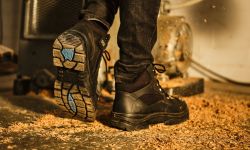We offer a range of Steel Blue boots that are Static Dissipative, meaning they dissipate the amount of static electricity build-up in your body. In fact, they actually conduct the static electricity through the soles and into the ground. This offers a level of protection against ignition hazards such as flammable materials and gases.
If you work with flammable materials, ignitable gases, sensitive electronic equipment or in an environment that creates static electricity build-up (where you get ‘zapped’ from touching doors and machinery), you’ll benefit from these Steel Blue boots.
Our Static Dissipative range of Steel Blue safety boots comply with American Safety Footwear Certification ASTM F2413. Soft Toe work boots that include Steel Blue’s Static Dissipative technology comply with American Safety Footwear Certification ASTM F2892.
Static Dissipative work boots should be cleaned and tested regularly to ensure the Static Dissipative properties haven’t deteriorated. Flexing, contamination and moisture can change their electrical resistance.


